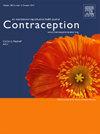评估计划生育环境中的歧视经历:探索性因素分析
IF 2.3
2区 医学
Q1 OBSTETRICS & GYNECOLOGY
引用次数: 0
摘要
目标鉴于高质量、以人为本的医疗保健的重要性,尤其是对经历过生殖压迫的群体而言,本研究旨在测试 Bird 和 Bogart(2001 年)开发的九个项目的计划生育环境中终生受歧视经历测量方法的心理测量特性。方法数据来自具有全国代表性的 "以人为本的避孕普及度量调查"(未加权 n=3059)。我们使用主轴提取和 Promax 旋转法进行了探索性因子分析。我们使用欧米茄系数评估了可靠性。为了评估已知群体的有效性,我们采用了调查抽样加权线性回归,将种族作为预测因子,将歧视量表得分作为结果变量。结果因子分析使用 7/9 个歧视项目得出了一个双因子解决方案:(1)计划生育关怀中的人际歧视,包括反映区别对待和不尊重的项目;(2)计划生育关怀中的种族刻板印象,包括基于种族/民族对福利状况、家庭规模、性行为和性传播疾病的假设。该测量结果显示出很强的可靠性(Ω系数为 0.97)和拟合度(TLI=0.988,RMSEA=0.066)。已知群体有效性测试表明,与白人受访者相比,有色人种在计划生育环境中遭受歧视的程度更高。结论这项评估计划生育环境中歧视经历的测量方法的验证为研究种族歧视的普遍性及其对生殖自主权(包括首选方法的使用)和获得护理的影响提供了支持工具。了解这些影响可以为促进获得高质量、公平和公正的生殖保健服务的干预措施提供依据。本文章由计算机程序翻译,如有差异,请以英文原文为准。
ASSESSING EXPERIENCES OF DISCRIMINATION IN FAMILY PLANNING SETTINGS: AN EXPLORATORY FACTOR ANALYSIS
Objectives
Given the importance of high-quality, person-centered care, particularly for communities who have experienced reproductive oppression, this study aimed to test the psychometric properties of a nine-item measure of lifetime experiences of discrimination in family planning settings developed by Bird and Bogart (2001).
Methods
Data came from the nationally representative Person-Centered Contraceptive Access Metrics survey (unweighted n=3,059). We performed an exploratory factor analysis using principal axis extraction and Promax rotation. We assessed reliability using the coefficient omega. To assess known-groups validity, we employed weighted linear regression with survey sampling weights, using race as the predictor and the discrimination scale score as the outcome variable.
Results
The factor analysis resulted in a two-factor solution using 7/9 discrimination items: (1) Interpersonal Discrimination in Family Planning Care, including items reflecting differential treatment and disrespect; and (2) Racial Stereotyping in Family Planning Care, capturing assumptions based on race/ethnicity about welfare status, family size, sexual behavior, and sexually transmitted diseases. The measure demonstrated strong reliability (coefficient omega 0.97) and goodness-of-fit (TLI=0.988, RMSEA=0.066). Known-groups validity testing indicated that people of color experienced higher levels of discrimination in family planning settings compared to White respondents.
Conclusions
The validation of this measure assessing experiences of discrimination in family planning settings provides a tool to support research on the prevalence of racial discrimination and its impact on reproductive autonomy, including preferred method use, and access to care. Understanding these impacts can inform interventions promoting access to high-quality, equitable, and just reproductive healthcare.
求助全文
通过发布文献求助,成功后即可免费获取论文全文。
去求助
来源期刊

Contraception
医学-妇产科学
CiteScore
4.70
自引率
17.20%
发文量
211
审稿时长
69 days
期刊介绍:
Contraception has an open access mirror journal Contraception: X, sharing the same aims and scope, editorial team, submission system and rigorous peer review.
The journal Contraception wishes to advance reproductive health through the rapid publication of the best and most interesting new scholarship regarding contraception and related fields such as abortion. The journal welcomes manuscripts from investigators working in the laboratory, clinical and social sciences, as well as public health and health professions education.
 求助内容:
求助内容: 应助结果提醒方式:
应助结果提醒方式:


